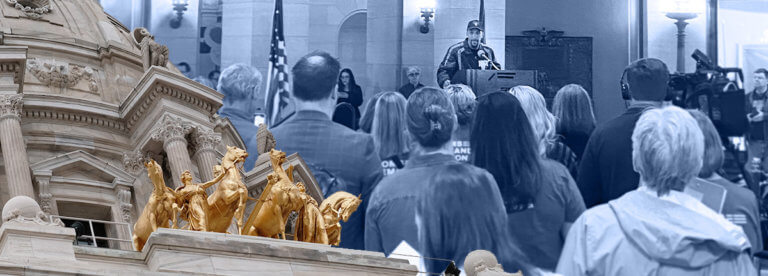Audio
|
Video
|
Tom Emmer’s Record on Jobs
|
|
Katie: “Hi, we’re the Emmers.”
|
On Screen: Tom and Jacquie Emmer with their 7
children
Graphic: THE EMMERS
|
Government recovery spending
creates jobs in Minnesota. The State of Minnesota has received $3,226,031,026
in federal recovery spending as of March 31, 2010, according to the
Recovery.gov Web site. This money has
created or saved more than 11,027 jobs. [Recovery.gov, accessed 5/13/2010]
Minnesota received
$447,485,056 for K-12 education in recovery spending. The funds are for “the support of public
elementary, secondary, and postsecondary education and, as applicable, early
childhood education programs and services,” and will create 5,868 jobs. [stimuluswatch.org, accessed 7/20/2010]
Minnesota received
recovery spending for weatherizing homes.
The ARRA provided $131,937,411 to weatherize homes. [stimuluswatch.org, accessed 7/20/2010]
Recovery spending
will fund $82,564,000 to “provide low-interest loans and principal
forgiveness to local gov’t for clean water infrastructure projects.” [stimuluswatch.org, accessed 7/20/2010]
|
|
Joey: “That’s
our dad, he’s running for governor.”
|
On Screen: Joey Emmer
Graphic: JOEY
|
Emmer opposed a
job creation bill. On March 29, 2010,
Emmer voted against a DFL-written jobs bill, which passed the House
112-20. Amongst the provisions are
tax credits for “angel” investors who spend on startup businesses. These tax credits are the only proposals in
the bill that have a cost, and the $10 million tab would be covered by
eliminating tax loopholes related to real estate investment trusts (REITs).
Much of the bill involves changes to rules for tax-increment finance (TIF)
districts [Minnesota House of Representatives, HF 2695 2010, House Journal 9761]
|
|
Katie: “And he’s really excited about it.”
|
On Screen: Katie Emmer
Graphic: KATIE
|
According to the Minneapolis-St.Paul
Business Journal, the bill included incentives for Ford Motor Co. to keep a
St. Paul assembly plant open, saving 750 jobs which would be lost if the
plant closed. The incentives reportedly would help Ford pay for renovations
needed to “retrofit the plant into a dual platform facility, allowing it to
produce more models than the Ranger light truck.” The incentives also
included “tax credits for job retention and creation, and other benefits.”
[Twin Cities Business Daily, 4/1/2010]
|
|
Tripp: “Always talking about cutting taxes and
reforming government.”
|
On Screen: Tripp Emmer
Graphic: TRIPP
|
According to
Session Daily, the Minnesota Legislature’s in-house publication, the bill
included an “angel investor” credit for investors who put money in burgeoning
small businesses. [Session Daily, 3/29/2010]
|
|
Jack: “And creating jobs for Minnesota.”
|
On Screen: Jack Emmer
Graphic: JACK
|
According to the
Minnesota Department of Revenue, the maximum small business investment “angel
investor” tax credit was $2.5 million in 2010 and doubled for FY 2011 – 2014.
|
|
Bobby: “Believe me, he creates plenty for us.”
|
On Screen: Bobby Emmer
Graphic: BOBBY
|
On Feb. 17, 2010, the New York
Times reported that various studies by leading economic research firms showed
that the federal stimulus package had created or saved between 1.6 million
and 1.8 million jobs nationwide. The
Times reported:
Perhaps the best-known economic research firms are
IHS Global Insight, Macroeconomic Advisers and Moody’s
Economy.com. They all estimate that the bill has added
1.6 million to 1.8 million jobs so far and that its ultimate impact will be
roughly 2.5 million jobs. The
Congressional Budget Office, an independent agency, considers these estimates
to be conservative. [New York Times, 2/17/2010]
|
|
|
On Screen: Various Emmer children doing odd-jobs;
mowing the lawn, doing dishes, taking out the trash, fixing a car
|
On December 17, 2009, the Center
on Budget and Policy Priorities released a study that said the stimulus
package was directly responsible for pulling between 42,000 and 91,000
Minnesotans out of poverty. [Center on
Budget and Policy Priorities, 12/17/2009]
|
|
Tom Emmer: “We’ve been blessed. Seven beautiful kids
living in this amazing state. Minnesota families are struggling. We need to
pick ourselves up, create jobs and get our economy moving.”
|
On Screen: Tom Emmer
Graphic: Tom Emmer
|
Emmer opposed the
job-creating American Recovery and Reinvestment Act. On January 22, 2009, Rep. Tom Emmer posted
a press release on his Web site attacking the Federal Stimulus program as an
“economic ‘stimulus’ package that adds another trillion dollars to our
national debt,” and said the Minnesota Republicans’ “Emergency Jobs Stimulus
Bill” was better for the state:
Our citizens, our taxpayers and especially our
business owners deserve better; this bill gives our state a chance to compete
for new jobs. [Office of Tom Emmer,
1/22/2009]
|
|
Narrator: “Tom Emmer”
Tom Emmer: “It’s time for a new direction.”
|
On Screen: Tom Emmer
Graphic: REFORM
REDESIGN
Graphic: IT’S TIME FOR A NEW DIRECTION
Disclaimer: PAID FOR BY TOM EMMER FOR GOVERNOR
|
On March 3, 2009, the Center on
Budget and Policy Priorities published a state-by-state breakdown of fiscal
aid sent directly to Minnesota as a result of the American Recovery and
Reinvestment Act. According to the report, Minnesota received $3.87 billion
in aid from FY 2009-2010, including more than $2 billion in fiscal relief for
medicaid, more than $17 million to retrain workers who lost their jobs, and
more than $1.5 billion in block grant funding. [Center on Budget and Policy Priorities,
3/3/2009]
|
|
|
|
On September 26, 2008, the
Center on Budget and Policy Priorities praised the stimulus proposal’s for
its strategic division of $14 billion among states according to need.
According to the Center on Budget and Policy Priorities, Minnesota was a
“Tier A” state for fiscal aid, one of the 25 states hit hardest by the
recession. From the Center on Budget and Policy Priorities:
Fiscal woes are not, however, uniform across states.
Some states face severe budget crises and the need to impose very large
spending cuts or tax increases. Others face less severe, but still
significant budget problems. A third group of states — particularly those
with mineral wealth — are faring better.
In recognition of this reality, the House stimulus
plan targets most of its fiscal relief to the states with the weakest
economies. [Center on Budget and
Policy Priorities, 9/26/2008]
|


